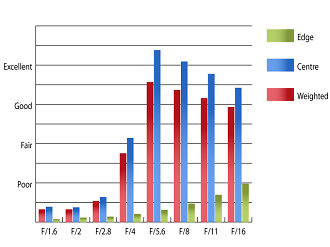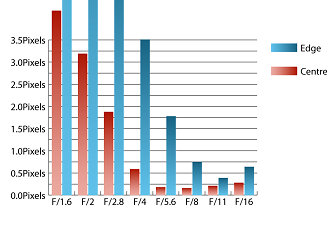Lensbaby Velvet 56mm f/1.6 Macro Review
Lensbaby Velvet 56mm f/1.6 1:2 Macro Performance
Of all the things this lens was designed for, photographing test charts wasn't one of them. Imatest struggled with the haziness of the images and reported very low levels of sharpness at fast apertures. This isn't the whole story though, as images have much more detail within them than testing would have you believe. You may just have to take my word for it, for now. As the aperture is stopped down, the hazy effect is reduced, with it almost completely disappearing from the centre of the image at f/5.6 and beyond. Here sharpness approaches outstanding levels in the centre of the frame.
How to read our charts
The blue column represents readings from the centre of the picture frame at the various apertures and the green is from the edges. Averaging them out gives the red weighted column.The scale on the left side is an indication of actual image resolution. The taller the column, the better the lens performance. Simple.
For this review, the lens was tested on a Nikon D600 using Imatest.
The hazy effect also messes with Imatest's ability to give accurate chromatic aberration readings. As you can see from the graph, Imatest reported fringing that is off the scale. To look at, actual chromatic fringing doesn't seem so bad.
How to read our charts
Chromatic aberration is the lens' inability to focus on the sensor or film all colours of visible light at the same point. Severe chromatic aberration gives a noticeable fringing or a halo effect around sharp edges within the picture. It can be cured in software.Apochromatic lenses have special lens elements (aspheric, extra-low dispersion etc) to minimize the problem, hence they usually cost more.
For this review, the lens was tested on a Nikon D600 using Imatest.
Falloff of illumination towards the corners is typical for a fast standard lens. The corners are 1.78 stops darker than the image centre at f/1.6 and visually uniform illumination isn't achieved until the aperture is stopped down to f/4 or beyond.
Imatest detected 2.09% barrel distortion, which is a fairly typical for a wide aperture lens like this, but may still become visible in images with straight lines close to the edges. The distortion pattern is uniform across the frame, so should be relatively straightforward to correct in image editing software afterwards.
This lens is highly susceptible to flare, with only a bit of sunshine being required to create all sorts of crazy ghosting in images. Whether this is a drawback, or not, will depend largely on what you expect from the lens.
Value For Money
With a price at launch of £419, this lens seems reasonably priced for a macro lens with a fast maximum aperture, although it isn't straightforward to compare with other lenses, as there is no direct equivalent available at the moment.
Add your message
Please login here or if you've not registered, you can register here. Registering is safe, quick and free.
photodo Stats
428 MTF tests
74 in-depth photodo reviews
100+ users join each day
Help the lens community by reviewing or rating a lens today via our lens search
Latest Lens Reviews
- Chinon 28mm f/2.8 Vintage Lens Review
- Canon EF 70-200mm f/4L IS II USM Lens Review
- Samyang AF 85mm f/1.4 EF Review
- Sigma 70mm f/2.8 DG Macro Art Review
- Samyang AF 24mm f/2.8 FE Review
- Meike 50mm f/1.7 Review
- Tamron 70-210mm f/4 Di VC USD Review
- Lensbaby Burnside 35mm f/2.8 Review
- Asahi Super Takumar 50mm f/1.4 Review
- Asahi Super-Multi-Coated Takumar 135mm f/3.5 Review


